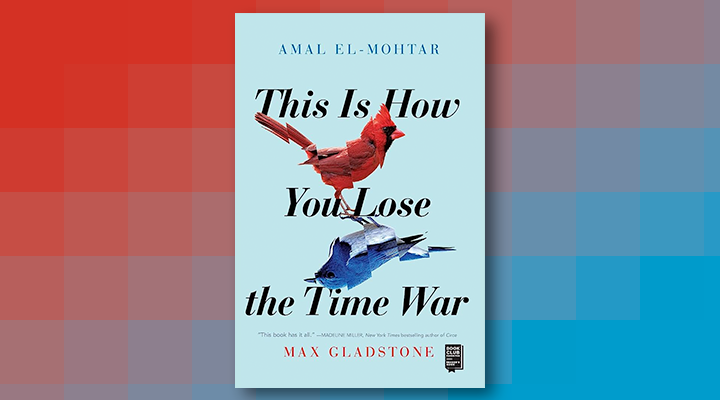"This is How You Lose the Time War" is a Time Travel Romance with Teeth

Universes collide, literally, in This is How You Lose the Time War (Saga Press, 2020), a layered, emotionally complex time travel-cum-romance from award-winning co-authors Amal El-Mohtar and Max Gladstone. It is equally a tale of sci-fi espionage, a love story, and a rip-roaring adventure, featuring some of the most impressive, imaginative set pieces in any book you’ll read this year. El-Mohtar and Gladstone are two authors at the top of their game; in joining forces they’ve sent notice to the rest of speculative fiction: they’re coming for all the awards.
Two agents on opposite sides of an endless war raging across time and space, affectionately known to one another as Red and Blue, meet cute in the most unusual way: via a letter found on the battlefield. Red encounters the missive in a world beyond apocalypse, her hands covered in blood of recently slain enemies, adrenaline pumping through her veins. She is greeted by three simple words: “Burn before reading.” Thus begins a correspondence between two soldiers on opposite sides of a war that has never begun because it has always been. Their relationship starts off snarky and baiting—like a fatal game of cat and mouse with enormous stakes—but slowly turns into one of respect, then something resembling passion, love, and hope for the future.
The story unfolds in epistolary format, through the back-and-forth of letters, Red to Blue and Blue to Red, that at once establish the complex, mutating relationship between the two, and drive forward a plot that progresses with the forward momentum of an avalanche. But these letters do not always come in the form of pen and ink: they are sometimes written in the bubbles of a working MRI machine found in a dilapidated hospital, or the sting of an insect, or the taste of a poisonous berry.
A brilliant example of how to weave a strong narrative around big ideas and subtle themes.
Bookending the found texts are brief interstitial chapters that unfold in a more traditional, though by no means straightforward, third-person voice, giving us a glimpse of Red and Blue in action. The two agents walk a tightrope as they weft and wend their way through a war that crosses literal eons—from the time of the dinosaurs, to futures beyond anything we can comprehend—remaining ostensible enemies, save for the bond of friendship and love blossoming between them.
The science fiction ideas in play are immense: Red and Blue’s factions— the machine-focused Agency and the biologically minded Garden, respectively—seek to manipulate time in ways small and subtle, but are nonetheless monstrous in their desire to tilt the ongoing Time War one way or the other. Red and Blue travel through various strands on the braid of time, sometimes living whole lives in host bodies until they pinpoint precise moment when their mission objectives can be achieved:
At the labyrinth’s heart there is a cavern, and soon into that cavern will come a gust of wind, and if that wind whistles over the right fluted bones, one pilgrim will hear the cry as an omen that will drive her to renounce all worldly goods and retreat to build a hermitage on a distant mountain slope, so that hermitage will exist in two hundred years to shelter a woman fleeing with child in a storm, and so it goes. Start a stone rolling, so in three centuries you’ll have an avalanche. (Ch. 3)
El-Mohtar and Gladstone examine historical manipulation—the way small knobs slightly turned, affecting the flapping of a metaphorical butterfly’s wings in Shanghai, and thus a hurricane elsewhere, with far reaching political, religious, and social implications—suggesting parallels to the way social and political agendas are laid out and manipulated by bad faith actors manipulating information streams in our world right now. SF has always been at its best when using big ideas to examine modern sociopolitical problems; This is How You Lose the Time War is a brilliant example of how to weave a strong narrative around big ideas and subtle themes.
But as much as it is a substantive work, this novella is all about delivering a message with style: “Red wrote too much too fast,” the narrator says. “Her pen had a heart inside, and the nib was a wound in a vein. She stained the pain with herself.” El-Mohtar and Gladstone, two of speculative fiction’s finest prose stylists, have bled themselves all over the page too. Every sentence, every word drips with meaning and emotion, florid displays that never obfuscates the narrative. As the story unfurls, and the letters grow ever fuller with furious love, it becomes clear that Red and Blue are seeking each other’s companionship for entirely different reasons. For Red, their coupling allows her to abandon loneliness; for Blue, it’s an escape from the shackles of her community. It’s a heartbreaking dichotomy, and through their growing bond, you can see the cries of those looking to escape the circumstances they have inherited from a series of choices and variables made and manipulated by others.
The writing approaches the density of poetry at times, but still the pages fly by. The story turns wheels in the brain, sets the heart pounding, and lingers in the memory. It’s impossible to resist the delicate unfurling of attraction, lust, adoration, and love between Blue and Red—and a marvel to realize that the whole affair works just as well as an unputdownable espionage thriller. The best books offer a new experience every time you read them; this one is wrapped in so many layers, cross-crossed with so many different possibilities and through lines, I don’t expect I’ll ever read it the same way twice.
This Is How You Lose the Time War by Amal El-Mohtar and Max Gladstone is available now from Saga Press. This review was originally published on the Barnes and Noble SF&F Blog.




Member discussion